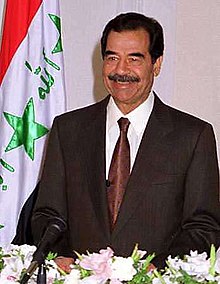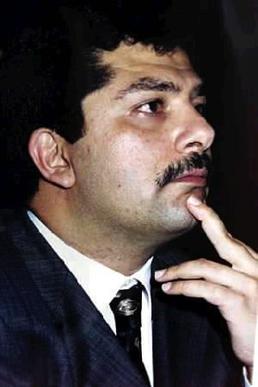
Qusay Saddam Hussein al-Nasiri al-Tikriti was an Iraqi politician, military leader, and the second son of Saddam Hussein. He was appointed as his father's heir apparent in 2000. He was also in charge of the Republican Guard, a branch of the Iraqi military. Qusay, his son Mustafa, and his brother Uday were killed in a U.S. raid in Mosul.

Saddam Hussein Abd al-Majid al-Tikriti was an Iraqi politician and revolutionary who served as the fifth president of Iraq from 1979 to 2003. He also served as prime minister of Iraq from 1979 to 1991 and later from 1994 to 2003. He was a leading member of the revolutionary Arab Socialist Ba'ath Party and later the Baghdad-based Ba'ath Party and its regional organization, the Iraqi Ba'ath Party, which espoused Ba'athism, a mix of Arab nationalism and Arab socialism.
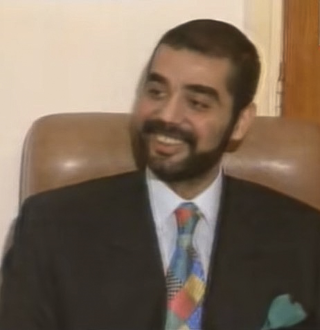
Uday Saddam Hussein was an Iraqi politician and the elder son of Saddam Hussein. He held numerous positions as a sports chairman, military officer and businessman, and was the head of the Iraqi Olympic Committee, Iraq Football Association, and the Fedayeen Saddam.

Tariq Aziz was an Iraqi politician who served as Deputy Prime Minister, Minister of Foreign Affairs and a close advisor of President Saddam Hussein. Their association began in the 1950s when both were activists for the then-banned Arab Socialist Ba'ath Party. He was both an Arab nationalist and a member of the Chaldean Catholic Church.

Barzan Ibrahim Hassan al-Tikriti, also known as Barazan Ibrahim al-Tikriti, Barasan Ibrahem Alhassen and Barzan Hassan, was one of three half-brothers of Saddam Hussein, and a leader of the Mukhabarat, the Iraqi intelligence service. Despite falling out of favour with Saddam at one time, he was believed to have been a close presidential adviser at the time of his capture by U.S. forces in 2003. On 15 January 2007, Barzan was hanged for crimes against humanity. He was decapitated by the hangman's rope after errors were made calculating his body weight and length of drop from the platform.
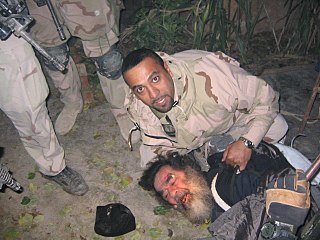
Saddam Hussein, the deposed president of Iraq, was captured by the United States military in the town of Ad-Dawr, Iraq on 13 December 2003. Codenamed Operation Red Dawn, this military operation was named after the 1984 American film Red Dawn.

The Victory Arch, officially known as the Swords of Qādisīyah, and popularly called the Hands of Victory or the Crossed Swords, are a pair of triumphal arches in central Baghdad, Iraq. Each arch consists of a pair of outstretched hands holding crossed swords. The two arches mark the two entrances to Grand Festivities Square and the parade ground constructed to commemorate the Iran–Iraq War, started and led by Iraq's then-president Saddam Hussein. The arches were opened to the public on 8 August 1989. It is one of Baghdad's visitor attractions and near to the Monument to the Unknown Soldier.

Grand Ayatollah Sayyid Abu al-Qasim al-Musawi al-Khoei was an Iranian-Iraqi Shia marja'. Al-Khoei is considered one of the most influential twelver scholars.
The following lists events in the year 2003 in Iraq.
Events in the year 2005 in Iraq.

Al-Firdos Square is a public open space in central Baghdad, Iraq. It is named after the Persian word Ferdows, which means "paradise". The site has been the location of several monumental artworks.

The trial of Saddam Hussein was the trial of the deposed President of Iraq Saddam Hussein by the Iraqi Interim Government for crimes against humanity during his time in office.
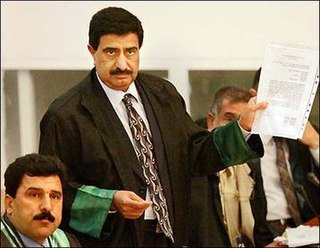
Khamis al-Obeidi was a lawyer defending Saddam Hussein and Barzan Ibrahim al-Tikriti, from the time the former leader's trial began in Baghdad on October 19, 2005, until his assassination. He was a Sunni Muslim, was married and had three children.
Ismail Hafidh al-Lami — known as Abu Deraa is an Iraqi Shia militant whose men have been accused of retaliatory terrorizing and killing of Sunnis.

Al-Mansour is one of the nine administrative districts in Baghdad, Iraq. It is in western Baghdad and is bounded on the east by al-Karkh district in central Baghdad, to the north by Kadhimiya, to the west by Baghdad International Airport, and to the south by Baghdad Airport Road, on the other side of which is al-Rashid district.

The Bush–Aznar memo is reportedly a documentation of a February 22, 2003 conversation in Crawford, Texas between US president George W. Bush, Prime Minister of Spain José María Aznar, National Security Advisor Condoleezza Rice, Daniel Fried, Alberto Carnero, and Javier Rupérez, the Spanish ambassador to the U.S. British Prime Minister Tony Blair and Italian Prime Minister Berlusconi participated by telephone. Rupérez transcribed the meeting's details which El País, a Madrid daily newspaper, published on September 26, 2007. The conversation focuses on the efforts of the US, UK, and Spain to get a second resolution passed by the United Nations Security Council. This "second resolution" would have followed Resolution 1441. Supporters of the resolution also referred to it as the "eighteenth resolution" in reference to the 17 UN resolutions that Iraq had failed to comply with.

The Umm al-Qura Mosque, also known as the Umm al-Ma'arik Mosque, is a mosque located in Baghdad, Iraq. It was the city's largest place of worship for Sunni Muslims, but it has also become the location of a Shi'a hawza and a place of refuge for many fleeing the terrorists' depredations in the Anbar Province. It was designed to commemorate former Iraqi President Saddam Hussein's self-proclaimed victory in the Gulf War (1990–1991) and was intended to serve as a personal tribute to Saddam himself. It is located in the Sunni-populated al-Adel area of western Baghdad.

The Faith Campaign was an Islamist campaign conducted by the Iraqi Ba'ath Party, beginning in 1993. The campaign involved a variety of policies, including greater freedoms being granted to Islamist groups, greater resources being put into religious programmes, increased use of Islamic punishments, and a greater emphasis being put on Islam in all sectors of Iraqi life.
Reactions to the execution of Saddam Hussein were varied. Some strongly supported the execution, particularly those personally affected by Saddam's actions as leader. Some of these victims wished to see him brought to trial for his other actions, alleged to have resulted in a much greater number of deaths than those for which he was convicted. Some believed the execution would boost morale in Iraq, while others feared it would incite further violence. Many in the international community supported Saddam being brought to justice but objected in particular to the use of capital punishment. Saddam's supporters condemned the action as unjust.

Mohamed Makiya was an Iraqi architect and one of the first Iraqis to gain formal qualifications in architecture. He is noted for establishing Iraq's first department of architecture at the University of Baghdad and for his architectural designs which incorporated Islamic motifs such as calligraphy in an effort to combine Arabic architectural elements within contemporary works.
